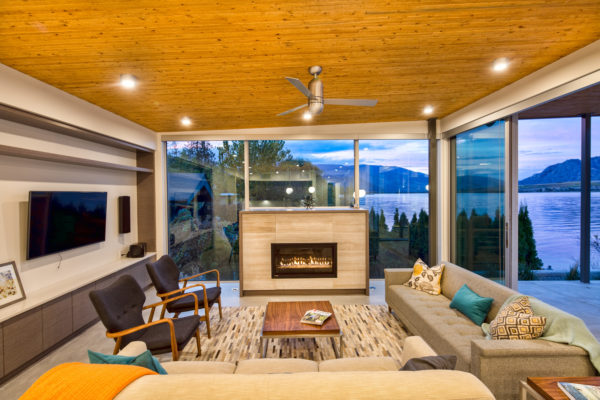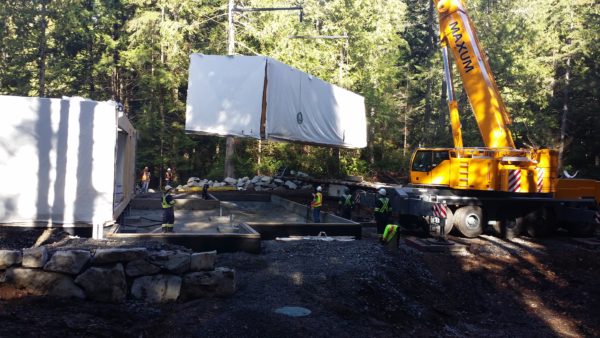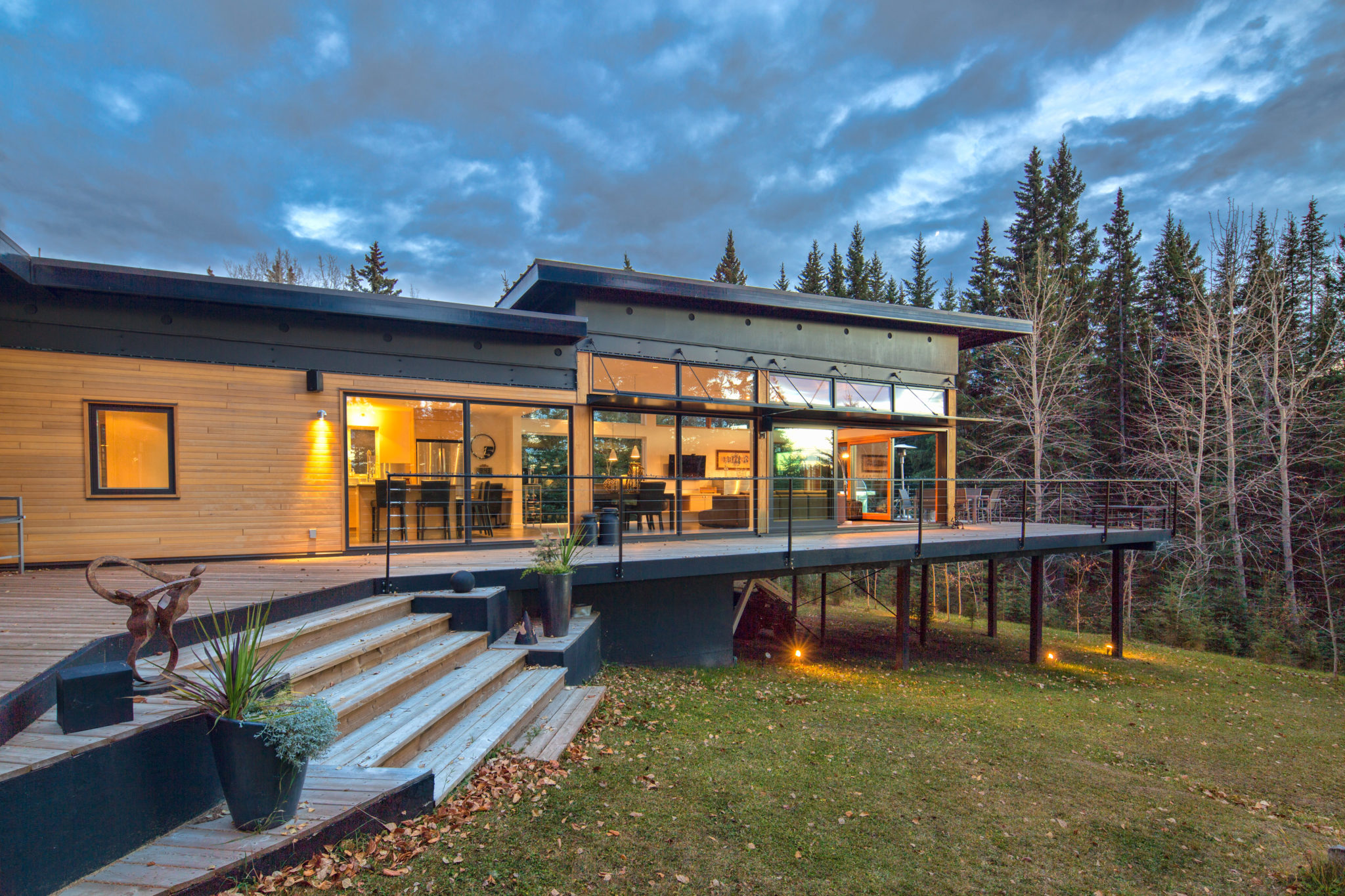Don’t let the word “modular” put you off. Once associated with mobile—or trailer park—homes, today’s designs are contemporary and stylish, with prices ranging from extremely affordable to ultra-luxurious.
B.C. buyers are catching on, too, snapping them up as fast as they roll off the production line.
The old stigma is fading as new generations jump on the opportunity to buy a newly built home that’s attractive, energy-efficient and with a faster building process than a traditional home.
When Carolynn and Irvin Kelly started shopping around for a new property in Osoyoos, the couple was disappointed to find the local housing stock in their price range was old and shabby. Instead, they decided to buy an acre of land and shop around for a house.
They stepped inside a modular show home in Penticton and liked it so much, they bought it right off the lot. “I walked into the modular and it was, wow, it was beautiful— and the price was great,” says Carolynn. “Every detail is nice: there are lights under the eaves, the kitchen has lights under the countertops, it has three bedrooms and a big walk-in closet.”
These are not the mobile homes of 1970s trailer-park vintage. The only difference between modular and conventional housing is that one is built in a factory, says Mark Huchulak, president and CEO of Jandel Homes, an Alberta-based company that recently expanded to B.C.
“Modular is a construction method, not a type of house. We use the same lumber, we use the same building codes. The only difference is that they are being built indoors. I can walk down these new subdivisions where there are modular and stick-build homes and you wouldn’t be able to tell the difference,” says Huchulak.
“One thing I always say is: ‘Would you get on an airplane that has been built on the side of a runway? Or would you rather it be built in a factory?’ When houses are built in a factory, precision is very high.”
Modular designs span everything from tiny cabins to luxuriously large, single-family homes. At the top end of the market is Karoleena Homes, owned by Kamloops- based Horizon North.
“Our Karoleena product is quite frankly in the luxury range with high-end finishing and contemporary design,” says Joseph Kiss, senior vice-president of modular solutions at Horizon North. “We have a number of standard designs, which range from laneway or tiny homes all the way up to 3,000 square feet plus. Our designs are West Coast or mountain contemporary, with mid-grade to high-end finishes.”
Once the home is on the foundation, it’s sold like typical real estate and your average citizen would not know it was a modular build.
“When you’re in the finished product, it’s indistinguishable from homes built conventionally,” says Kiss. “It’s a full turnkey approach with no cost uncertainty and no time uncertainty. The homes are built in a factory environment, so there is no impact or delays from weather.”
Time is a major factor for most buyers, he adds.
“If you get your house six to nine months quicker, how much is that worth? The main drivers for many of our clients are cost certainty, schedule and location in terms of minimal disruption to neighbours. Also, the reason we have people calling Karoleena is the esthetics. That’s one of the biggest drivers. There’s really nothing else like it on the market,” says Kiss.
FACTBOX WHAT IS A MODULAR HOME?  Modular homes are constructed in a factory and shipped to their destination fully complete inside. A crane lifts the modules onto the foundation and secures them together. They are built with factory precision and adhere to Canadian building codes.
Modular homes are constructed in a factory and shipped to their destination fully complete inside. A crane lifts the modules onto the foundation and secures them together. They are built with factory precision and adhere to Canadian building codes.
Cost range: As little as $125 per square foot up to $350 per square foot for high end (they typically cost less than houses built on-site due to efficiencies from building the units indoors).
Time to build: Eight to 24 weeks, depending on the company and designs. Size: Everything from small cabins to single-family homes.
The size: depends on the number of modular sections desired
FIXED COSTS PREVENT STICKER SHOCK

As much as they loved living in Vancouver, Patrick and Suki Belbin had grown sick and tired of renting. The young professionals—a teacher and nurse—decided to move to the Okanagan in search of a more affordable lifestyle.
They settled in Penticton and purchased a single-family home on a large lot. Today, their mortgage is equivalent to what they were paying in rent for an East Vancouver basement suite.
If their story sounds familiar, it’s because this couple’s migration is part of a growing B.C. trend. As a result, smaller communities are developing a fresh energy.
The couple, who now have two children (ages one and three), recently decided to add a carriage house complete with a two-bedroom suite to their property.
“When we bought the place in Penticton, I wanted a big yard for kids to play and we wanted something that had potential,” says Patrick. “It’s an old house and we wanted to add a carriage house so that our family could visit for longer stays. Also, we can rent it out to pay for itself.”
They worked with Penticton-based Radec Group on the Cape Codstyle design and—using a combination of factory-built panels and traditional stick-framing—the house was ready to go within a matter of months. One of the big selling points of a factory-built housing company, adds Patrick, is the fact that the price they quote is the final price you are charged.
“Having the project done as a cost-certain model was definitely important to us. It’s like if you have a plumber coming to your house to fix your hot water heater. He might say it’s $600 to $700 over the phone, and then you get a bill for $1,200. With Radec, the numbers were what they said the numbers would be. The time is tighter and the numbers are tighter. I like that model.”
As for their decision to move to the Okanagan, Patrick confesses he does miss Vancouver sometimes, but that Penticton is “perfect for my family, perfect for our financial situation.”
“It’s amazing how the demographic has changed so quickly here,” he says. “I have other friends who used to live in Vancouver and are now in Penticton. It’s a family town all of a sudden—lots of kids.”


